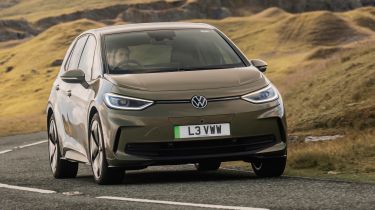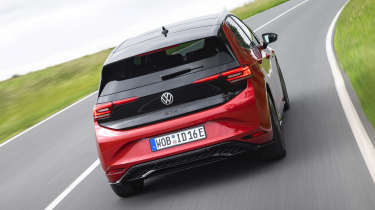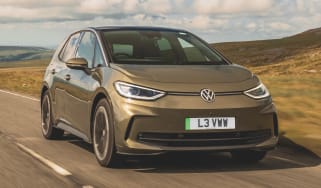Volkswagen ID.3 hatchback - Electric motor, drive & performance
It may not be as quick as a Tesla but the ID.3 has the acceleration to worry a Golf GTI
There’s really very little to fault when it comes to the Volkswagen ID.3’s driving experience – especially if you’re coming from a petrol or diesel car. It’s smooth, quick and quiet, and it’s even pretty responsive thanks to its zippy electric motor and rear-wheel drive layout. There’s only one version (and two batteries) currently on offer, but it’s the best of the bunch, so we’ve no issues in this respect.
Volkswagen ID.3 electric motor
Volkswagen launched the ID.3 with a 201bhp rear-mounted unit powering the rear wheels, while lower-powered versions have come and gone, and the latest entry-level ID.3 gets 168bhp. At the other end of the spectrum, GTX models get a much more potent 322bhp motor.
With its instant shove, the mid-tier ID.3 feels genuinely quick away from the lights, not only outpacing the Nissan Leaf and Renault ZOE but even making for an interesting comparison with a conventionally-powered Golf GTI. The ID.3 races from 0-37mph in just less than four seconds, aided by the absence of gearchanges. Most electric cars use a single-speed automatic system so there’s no need for gears like in a traditional car. Acceleration tails off somewhat above 50mph, but not completely. Opt for the GTX, and VW claims 0-62mph in 5.9 seconds, making it comfortably the quickest ID.3 but far from the punchiest electric car these days.
Braking feels more natural than in many rivals we've tried, though at times we did notice quite a bit of pedal travel before the discs came into contact with the pads, which can feel a little disconcerting if you’re trying to slow down gently. Despite tuning the braking system for sportier driving, the GTX’s pedal doesn’t feel much firmer. One way of mitigating this is by selecting B-mode, which ramps up the regenerative braking and slows the car automatically when you lift off the accelerator. This sensation isn’t as aggressive as in some rivals like the Kia Niro EV or Tesla Model 3, but it’ll harness energy that would otherwise be lost – sending it back into the battery and topping up the car’s charge. VW says that if you regularly use this setting, an ID.3 may never need its brakes replacing.
More reviews
In-depth reviews
Despite being taller and almost a third heavier than a Golf, the ID.3 has a lower centre of gravity thanks to its low-slung electric powertrain. Volkswagen's engineers have been able to make it feel more agile and lighter on its feet than the Golf. That's with standard suspension too; our experience in a car with the adjustable setup showed it to strike an ever better balance between ride and handling.
In short, despite being inherently quite stiff, the ID.3 doesn’t tend to get unsettled by rough road surfaces. The steering is well-weighted but there’s not a great deal of feedback, which isn’t a deal-breaker in regular models but does leave the GTX feeling a little uninvolving for a sporty variant. The GTX at least gets plenty of grip, for a surefooted feel, though with plenty of power and torque to the rear wheels, more extroverted driving can see the rear end nudge out of line, before electronics call time on your behaviour.
With no engine in the nose of the car, Volkswagen has had to work hard to ensure the ID.3 doesn’t suffer too much when it comes to wind and road noise – sounds that would otherwise be drowned out by a petrol or diesel motor at higher speeds. The result is a refined car that remains hushed even on the largest 20-inch wheels.
Placing the motor at the rear has also allowed the engineers to increase the steering angle of the front wheels, giving the ID.3 a smaller turning circle that makes previously unthinkable manoeuvres possible.














